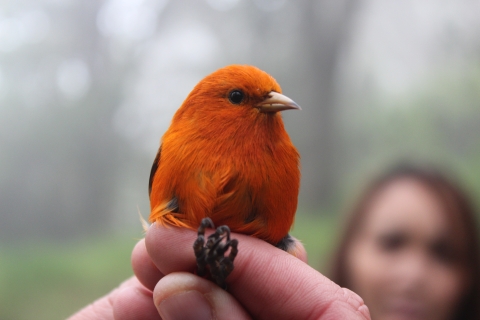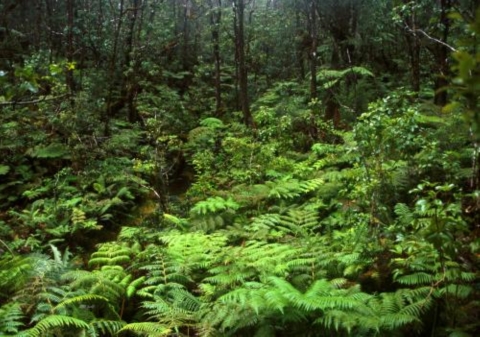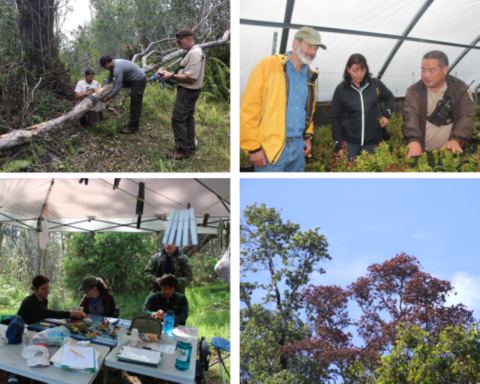FAST FACTS
- The Hawai‘i ‘ākepa is one of the smallest of the Hawai‘ian honeycreepers.
- Their “kee-wit” calls are quiet and their songs are a short, warbling trill.
- Their diet consists primarily of insects and spiders. They use their odd-shaped crossed bills to pry open ‘ōhi‘a buds, small seed pods, and galls in search of food.
- They have been known to drink nectar from ‘ōhi‘a and other flowers.
Wondering what the ‘ākepa sounds like? Click Here.
HAWAIIAN CULTURAL SIGNIFICANCE
ʻĀkepa - whose name means “quick, nimble, and active” in Hawaiian - were often observed actively foraging on tree tops. Some native birds are considered ʻaumakua or spiritual guardians. Traditionally, Hawaiians resourced birds for an array of uses. For example, the kia manu (bird catchers), would use feathers to make kāhili (long pole decorated with feather plumes at the end, signifying royalty), ʻahuʻula (cloaks), and mahiole (helmets).
RANGE
The ‘ākepa was once found on O‘ahu, Maui, and the Big Island, but are believed to dwell only on the Big Island today. Maui ‘ākepa were last heard in 1995. O‘ahu ‘ākepa were documented to be rare even in the 1800′s and are believed to be extinct today, with the last possible sighting in 1976.
The ‘ākepa can be found in ‘ōhi‘a and koa-‘ōhi‘a forests above 4,500 feet where they nest in the cavities of large old growth ‘ōhi‘a and koa trees.
BIGGEST THREATS:
Habitat Loss
Protecting the ‘ākepa means protecting their habitat. Since ‘ākepa nest exclusively in holes or cavities found in mature or old growth koa and ‘ōhi‘a trees, threats to the tree become threats to the bird. Hakalau Forest National Wildlife Refuge was established in 1985 to protect and manage endangered Hawaiian forest birds and their rain forest habitat.
Invasive species
In Hawai’i, more than 5,000 species have been introduced into the environment. While not all of them have taken hold and become destructive, their impacts have been severe, causing serious habitat degradation and species extinction.
Learn more about the threats caused by invasive species invasive species
An invasive species is any plant or animal that has spread or been introduced into a new area where they are, or could, cause harm to the environment, economy, or human, animal, or plant health. Their unwelcome presence can destroy ecosystems and cost millions of dollars.
Learn more about invasive species : Click Here
Some invasive species - like feral pigs - destroy habitat, while others can bring in diseases. Avian malaria - an introduced disease carried by invasive mosquitoes - has had a devastating impact on many of Hawaii’s endemic forest birds and has led to the disappearance of ‘Ākepa from the lower elevation forests where mosquitoes live.
CONSERVATION EFFORTS
The most important recovery strategy for the Hawai‘i ‘Ākepa is habitat protection. Since 1989, over 500,000 koa, ‘ōhi‘a, and other native plants have been planted as part of the refuge’s reforestation program, and those efforts are starting to pay off for the birds.
Learn more about Hakalau Forest Restoration
###
The U.S. Fish and Wildlife Service works with others to conserve, protect, and enhance fish, wildlife, plants, and their habitats for the continuing benefit of the American people. For more information, visit www.fws.gov/pacificislands, or connect with us through any of these social media channels at https://www.facebook.com/PacificIslandsFWS, www.flickr.com/photos/usfwspacific/, https://medium.com/usfwspacificislands or www.twitter.com/USFWSPacific.







